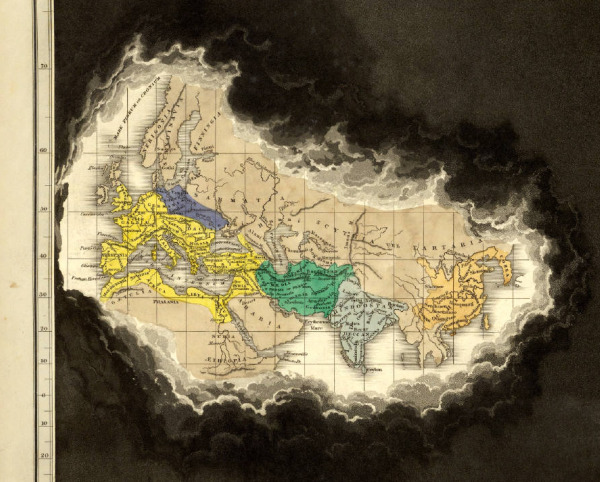April 2010 Archives
Hos David Weinberger kan man läsa mail från regissören till filmen "Only a Good Can Save Us", om Martin Heideggers nazism, med intressanta detaljer om Heidegger-familjens inställning till debatten om den stora filosofens medlöperi:
The film premiered in the Aula (auditorium) of Freiburg University on July 23 of this year. The response was phenomenal and I was invited back by popular demand to show the film again in Freiburg on October 21. The Heidegger family came and caused quite an incident. Hermann Heidegger kept yelling out during the film "Lüge, alles Lüge." (Lies, all lies!") and "nicht Wahr!" ("not true!").
 Jag noterade att bambu var ett inslag i gatuprotesterna i Bangkok, med vilket man byggde vassa barrikader förstärkta med gummidäck. Mitt i finansdistriktet. Natur möter betong. Perenner möter taggtråd.
Jag noterade att bambu var ett inslag i gatuprotesterna i Bangkok, med vilket man byggde vassa barrikader förstärkta med gummidäck. Mitt i finansdistriktet. Natur möter betong. Perenner möter taggtråd.På taket till Museum of Modern Art i New York har man just börjat bygga installationen Bambú: You Can't, You Don't, and You Won't Stop:
Big Bambú is a growing and changing sculpture―a vast network of 5,000 interlocking 30- and 40-foot-long fresh-cut bamboo poles, lashed together with 50 miles of nylon rope. It will continue to be constructed throughout the duration of the exhibition. The first phase of the structure―measuring about 100 feet long, 50 feet wide, and 30 feet high―will be completed by opening day, April 27. Subsequently, the artists and rock climbers will build up the eastern portion of the sculpture to an elevation of 50 feet. By summer, the western portion of the sculpture will be about 40 feet high. An internal footpath artery system will grow along with the structure, facilitating its progress.

Om du minns Bjarke Ingels TED-prat från i höstas, där han pratade om att Den Lilla Sjönjungfrun skulle ut på turné, nämligen till världsutställningen i Shanghai, så kan jag nu meddela att hon nu anlänt. Se ett inslag hos BBC. "A video installation by a Chinese artist will take the statue's place until it returns in November."
Untitled Project: LIBRAIRIE [Geneva] is a simulated bookshop made of hundreds of hand carved and painted copies of used paperback books from the 1960's and 1970's whose subjects range from social issues and existential philosophies to DIY crafts and self improvement. These representations of vintage paperbacks reveal their status as public things in the gathering of persons/things around a specific issue or matter of concern. The very space of the constructed bookshop/librairie reiterates the objective of public things as it becomes a literal platform for considering the relationships between persons, things and ideas.Yawn. Men man verkar onekligen ha lagt ned en massa tid på att karva fram alla de där Penguin-pocketerna.
Sid Vicious, Tupac Shakur, Foxy Brown, och nu senast Lil' Wayne, alla har de suttit av tid på fängelset på Rikers Island, i vattnet mellan Queens och Bronx. (Med 15 000 intagna är man i storlek med t.ex. Falköping). Men hur är det egentligen att vara bibliotekarie där? Jamie Niehoff berättar om sitt frivilligarbete i en New York Public Library-blogg:
Getting books back from the prisoners and letting them pick out new ones is a bit of controlled chaos. We stood outside the iron door to the house with our cart and had two prisoners come out at one time, check off their returned book, and pick out a new one. Each prisoner is allowed one book and one magazine. The most popular books are by far James Patterson's novels, so popular in fact that we have to lock them up after book service because they tend to disappear. I wonder if James Patterson has any idea. National Geographic is the magazine of choice, and there is an entire box of them to choose from, some as far back as the early 80's.
 New York Times bokblogg Paper Cuts kallar Cartographies of Time för "the most beautiful book of the year", och i ett bildspel hittar jag den just nu väldigt passande bilden ovan, ur Edward Quins kartverk An Historical Atlas; In A Series Of Maps Of The World As Known At Different Periods; Constructed Upon An Uniform Scale, And Coloured According To The Political Changes Of Each Period: Accompanied By A Narrative Of The Leading Events Exhibited In The Maps: Forming Together A General View Of Universal History, From The Creation To A.D. 1828.
New York Times bokblogg Paper Cuts kallar Cartographies of Time för "the most beautiful book of the year", och i ett bildspel hittar jag den just nu väldigt passande bilden ovan, ur Edward Quins kartverk An Historical Atlas; In A Series Of Maps Of The World As Known At Different Periods; Constructed Upon An Uniform Scale, And Coloured According To The Political Changes Of Each Period: Accompanied By A Narrative Of The Leading Events Exhibited In The Maps: Forming Together A General View Of Universal History, From The Creation To A.D. 1828.In successive maps, the clouds roll back to reveal how much of the world was known to the West at the time. The map at left shows the state of the West at the time of the death of Emperor Constantine, in 337.
Nu har jag ju inte läst klart Solar än, men det är lite kul att läsa om att den idé som bokens Nobelpristagande anti-hjälte knäcker/snor för att lösa världens energiproblem nu faktiskt blivit verklighet, när forskare vid Stanford-universitetet utvunnit elektricitet ur alger!
Ett väldigt intelligent samtal bara, mellan David Remnick och Ta-Hehisi Coates (börjar ca 8 min in, dryga timmen långt). Apropå Remnicks bok The Bridge: The Life and Rise of Barack Obama.
Hos den fantasieggande Atlas Obscura, som förtecknar kuriösa platser man gärna vill besöka, lär jag mig om de självmummifierade munkarna i Japan, som efter att ha fört en uttorkande diet satte sig i en grotta i lotusställning för att skrumpna ihop. Man kan idag hitta 16 av dessa mumiebuddhor i diverse kloster i Japan. Men jag tänker mest på dom som inte riktigt lyckades:
Not all monks who attempted self-mummification were successful. When the tombs were finally opened, some bodies were found to have rotted. These monks were resealed in their tombs. They were respected for their endurance, but they were not worshiped.
En artikel i PLoS ONE - "BioTorrents: A File Sharing Service for Scientific Data" - beskriver en ny tjänst - BioTorrents - som använder BitTorrent-tekniken för fildelning av stora mängder vetenskaplig data. Like.
 Barn ska introduceras tidigt till värdena hos modernistisk arkitektur och typografi, t.ex. med Eames House Blocks från House Industries, som dels bildar Case Study House No. 8 och dels introducerar typen Eames Century Modern:
Barn ska introduceras tidigt till värdena hos modernistisk arkitektur och typografi, t.ex. med Eames House Blocks från House Industries, som dels bildar Case Study House No. 8 och dels introducerar typen Eames Century Modern: In the true Eames spirit, your kids can create a ligneous yard sale on your living room rug while you're in deep conversation with your guests, then build this living landmark to demonstrate how you are properly introducing them to important bits of culture. And, as a whole, they take up much less room than those awkward and unsightly Montessori toys.(via: Inhabitots)
Buster Benson (som har en förskräckligt fin s.k. hemsida) har skapat 750 Words, som helt enkelt uppmanar dig att skriva tre sidor om dagen, ungefär 750 ord. Den har ett lite kul poängsystem (à la bowling) som ska uppmuntra dig:
1 base point for writing between 100 and 750 words on a given day. 2 base points for writing 750 words or more. An extra point too if you write all 750 words without getting distracted. In addition to your base 1-3 points per day, if you scored 1 point (think spare), you also add the number of base points you got the previous day. If you score 2 or 3 base points (think strike), you also add on the base points from the previous 2 days. So, basically, if you are on a writing streak, and hitting 750 words 3 or more days in a row (think turkey) you'll get 6 points a day (2 + 2 + 2). If you always write but never get to 750, you'll get 2 points a day (1 + 1). Confusing enough? Just ignore it.
The Chicago Manual of Style (@ChicagoManual) har en rätt underhållande FAQ-sektion, där man bland annat, under rubriken "Internet, Web, and Other Post-Watergate Concerns", hittar ett icke-svar på frågan hur man gör med uttryckssymboler (emotikoner, smileys), i synnerhet när de skrivs innanför parenteser:
A. Until academic standards decline enough to accommodate the use of emoticons, I'm afraid CMOS is unlikely to treat their styling, since the manual is aimed primarily at scholarly publications. And the problems you've posed in this note give us added incentive to keep our distance. (But I kind of like that double-chin effect.)
Fy satan vad gubbigt det där sista inlägget var (4 gubbar!), så här kommer Joanna Newsom som framför den underbara "Soft as Chalk", som kompensation:
Chrstopher Hitchens citerar Sir Martin Rees ("Astronomer Royal") i en essä om J.G. Ballard:
Most educated people are aware that we are the outcome of nearly 4 billion years of Darwinian selection, but many tend to think that humans are somehow the culmination. Our sun, however, is less than halfway through its lifespan. It will not be humans who watch the sun's demise, 6 billion years from now. Any creatures that then exist will be as different from us as we are from bacteria or amoebae....och samma dag läser jag detta i Solar:
A childless man of a certain age at the end of his fifth marriage could afford a touch of nihilism. The earth could do without Patrice and Michael Beard. And if it shrugged off all the other humans, the biosphere would soldier on, and in a mere ten million years teem with strange new forms, perhaps none of them clever in an apeish way. Then who would regret that no one remembered Shakespeare, Bach, Einstein, or the Beard-Einstein Conflation?
hallå
| www.flickr.com |
Jag heter Erik Stattin och det här är min blogg. Jag skriver om digital kultur, ungefär. Du får gärna tipsa mig om saker. Kontakta mig på erik.stattin@gmail.com. Jag är mymarkup på Twitter och Delicious.
![Untitled Project: LIBRAIRIE [Geneva]](http://farm3.static.flickr.com/2729/4448297834_87f8dc9254.jpg)